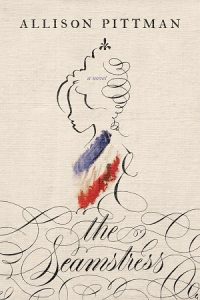The author explains the challenges of giving life to a minor character from a Dickens classic.
Allison Pittman, author of more than a dozen critically acclaimed novels, is a three-time Christy Awards finalist. Her new novel, The Seamstress (Tyndale House), expands on the story of a minor character from one of Charles Dickens’ classic novels. In this interview, Allison explains what inspired her to focus on this particular character, reveals what research went into writing the noel, and shares the core themes explored in the book…
The Seamstress reveals the untold story of a cameo character in Charles Dickens’s novel A Tale of Two Cities. What inspired you to elaborate on the life of this character in particular?
 At the end of the novel A Tale of Two Cities, the character Sydney Carton has this beautiful, sweet moment with a young seamstress. (Dickens describes her as a “little seamstress.”) It’s a moment meant to show the redemption of Sydney Carton, a man who sees himself as one who has wasted his life.
At the end of the novel A Tale of Two Cities, the character Sydney Carton has this beautiful, sweet moment with a young seamstress. (Dickens describes her as a “little seamstress.”) It’s a moment meant to show the redemption of Sydney Carton, a man who sees himself as one who has wasted his life.
The seamstress herself is nameless, appearing only in the final pages of the novel. Even so, left to herself, she is a powerful, important character. But—she mentions having a cousin in the country.
That little detail used to seem like a throwaway fact. Then I became a writer, and I learned that nothing is a throwaway fact. Why mention the cousin? The seamstress is a symbol. A metaphor. She doesn’t need a cousin.
I was standing in front of the students in my sophomore English class, discussing this final scene, and I had a throwaway line of my own: “I should write that story.”
Can you tell us about the research that went into writing this novel?
Well, I wish I could say it included a week-long visit to Paris and Versailles, but remember—the idea came to me while teaching an English class, so a research trip just wasn’t in the budget. I focused my research on four touchpoints: the Dickens novel to line up my story events with that final scene; a biography of Marie Antoinette to look for character insight beyond the cultural clichés; a fantastic book about the design, architecture, and history of the palace at Versailles; and a resource offering meticulous detail about the fashion of the time.
While I, of course, read widely for details of the history of the French Revolution, I paid close attention to the details of the revolution as filtered through those sources and points of view. I always hope that the history behind my stories will come to life through my story. I tried to take bits and pieces of the conditions that led France to this point of revolution and “assign” them to characters to carry them to life.
Tell us about some of the core themes explored in your book. How do you hope readers might relate these themes to their own lives and real-world experiences?
 I think, after sifting through the layers of the parallel stories, the core theme comes down to two concepts: honor and grace. In the story’s first pages, Gagnon acts with honor, taking in the orphaned cousins; moreover, he is honorable the entire time they are in his care, even when they grow from little girls into young women. He guards and shields them, honoring God in every moment, even when that moment means letting them go.
I think, after sifting through the layers of the parallel stories, the core theme comes down to two concepts: honor and grace. In the story’s first pages, Gagnon acts with honor, taking in the orphaned cousins; moreover, he is honorable the entire time they are in his care, even when they grow from little girls into young women. He guards and shields them, honoring God in every moment, even when that moment means letting them go.
Renée honors her country’s queen, even when popular opinion dictates such respect is not deserved.
And Laurette, in her darkest moment, honors what she knows to be good and right.
Even the rebel Marcel acts in a manner that he sees as honorable, ready to fight and die for those who cannot do so for themselves.
Ultimately, it is this sense of honor that drives all of these characters—for a time—to make choices that divide them from each other. And yet, after so much hurt, betrayal, desperation, and bloodshed, grace and forgiveness wrap them back up together.
There is a scene in the novel when all of the principal characters are gathered around a table, sharing a very meager meal. They differ in politics, in age, in ideology, and in experience. Still, there is kindness, civility, and a willingness to sacrifice for the good of each other.
We all have to do better, to want a better world for each other, even if it means not having everything exactly as we’d like it to be. We need to be willing to give, to listen, to share, and—yes—to speak, when our words can be measured and delivered with care.
Why is it important to explore these topics in our current culture?
Dickens famously opens his novel with the paradox: “It was the best of times, it was the worst of times…” He concludes that series of paradoxical statements by saying (forgive the paraphrase) that the events of his story take place in a time just like the present age.
To me, no matter when you read that novel, you are reading in the present age. When taken in superlative generalities, the tumultuous time of the French Revolution was no different than what and where and when we are living today.
The characters in the story are living in a time of upheaval: political, economic, religious, cultural—all fronts. Their world is changing, and the system under which they’ve been living is failing. It’s a time of unchecked violence, weak leadership, and a cultural trend toward secularism. So—I can see it. Can you?
Click through to find out how faith plays a role in the story!


